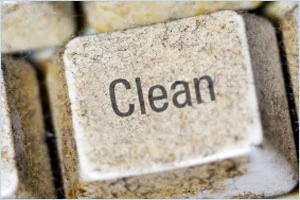Any business, whether for-profit or non-profit, relies on their data to make informed decisions. Having accurate data, however, makes a big difference in the quality of these decisions. What keeps data accurate? A good hygiene regimen.
Clean data means that the entries in an organization's database are current, both in content and in time. Content refers to aspects like contact information, preferred message vehicle, and activity notes, whereas time refers to whether or not a donor or patron has interacted with the organization within a reasonable amount of time.
When an employee inherits a messy database or is possessing a large amount of data, it can seem like a daunting task. Consistently maintaining certain processes will help minimize the difficulty of cleaning an old database. Below are five tips for making sure one’s data stays relevant and squeaky clean.
1) Know what the organization wants from their data.
Take some time to sit down and think about what information the organization is currently collecting and how that is informing organizational decision-making. Perhaps patron surveys are being used to collect mailing addresses when the organization really doesn’t communicate using direct mail. Maybe zip code information has not been a priority, but that data could be a great resource for informing future marketing strategies. This is the period to evaluate what the organization truly wants its data to say and make sure it’s being accurately collected for future constituents.
2) Merge duplicates.
It doesn’t take much to accidentally create multiple accounts for one person or business. From simple human error to patrons using new or different addresses, duplicates happen all the time. Luckily, most CRMs have a function that scans through data to search for possible duplicate entries. Making sure this scan is run once a month (or at least once before each major mailing or email) will make sure the organization is communicating with a targeted group of patrons, and it will ensure that those patrons are not receiving multiple copies. Duplicate emails can quickly lead to patron frustration, causing them to unsubscribe.
3) Scan for incomplete entries.
Source: Image from American Name Services
Run a query that checks for missing information. If the query finds patrons with blank spots in their contact information, find a way to update the missing information either by contacting the patron directly or by using other resources. One such resource is the National Change of Address Database (NCOA), which is kept by the United States Postal Service. The easiest way to access this is through a third party. If the organization outsources direct mailings to a mail house, they will do this automatically. Some CRM systems also have this option as an added feature. For example, Bloomerang has a partnership with an organization called Data Perfected, LLC, which takes all an organization’s data and runs it through the NCOA to see if any of their data matches and needs to be updated.
Another step would be to determine which patrons with missing information are worth reconnecting with. If they were a monthly donor that seems to have a taken a year off, they more more likely to be responsive if an organization reaches out to them. If it is a volunteer from a decade ago who hasn’t communicated with the organization in five or six years, it's unlikely worth the organization's time to contact them. It all depends on what data the organization has decided is important and who they want to gather it from, as determined in Tip #1.
4) Pay attention to bounced emails and mailing pieces.
Making sure that staff are on top of returned mailings is crucial. Make sure the database manager receives any piece of direct mail that was returned, and that they are notified about any bounced emails from electronic campaigns. This oversight will allow them to update that patron’s addresses, either by contacting them directly, or by entering the forwarding address on the bounced envelope. This is a simple step if it is done continuously, but it can quickly become an overwhelming task if it is allowed to build up.
5) Have a database maintenance plan.
Source: Image from WeClipArt.com, Inc.
Have a written document in place that creates a timeline for implementing these tips on a regular basis. Steps like scanning for duplicates or running data through the NCOA should be done monthly, while steps like reviewing what data the organization is collecting and changing strategies can occur quarterly or annually along with evaluations of organizational strategic goals. Checking on bounced emails and mailings should be a weekly task, keeping it manageable for staff. If organizational staff is limited, and the capacity for a dedicated database manager doesn’t exist, there are services available (certain CRMs, organizations, and consultants) who can take on some of the burden for a fee. However it happens, these habits are crucial in making sure that organizational data stays clean, accurate, and relevant as we all move forward into a new year.
References
“Five Tips for Maintaining Your Data”. WealthEngine. September 26, 2016. Accessed January 2, 2018. http://www.wealthengine.com/resources/blogs/five-tips-maintaining-your-data
Frankfurt, Tal. “Implementation Best Practices: Data”. Nonprofit Technology Network. June 21, 2015. Accessed January 2, 2018. https://www.nten.org/article/implementation-best-practices-data/
Neubarth, Michael. “Data Hygiene: Create a Culture of Cleanliness to Beat Bad Data”. TowerData, Inc. July 10, 2013. Accessed January 2, 2018. https://www.towerdata.com/blog/bid/116955/data-hygiene-create-a-culture-of-cleanliness-to-beat-bad-data
Rowland, Sara. “The Cost of Bad Data”. Nonprofit Technology Network. September 25, 2013. Accessed January 2, 2018. https://www.nten.org/article/the-cost-of-bad-data/
“Summer Cleaning: A Data Hygiene Checklist Any Nonprofit Can Reference”. npENGAGE. June 20, 2013. Accessed January 2, 2018. https://npengage.com/nonprofit-fundraising/summer-cleaning-data-hygiene-checklist-any-nonprofit-can-reference/
“The Ultimate Guide to NCOA Processing for Nonprofits”. Bloomerang. December 5, 2013. Accessed January 8, 2018. https://bloomerang.co/blog/the-ultimate-guide-to-ncoa-processing/






